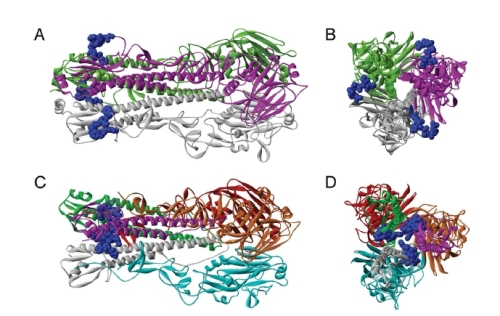The new influenza virus A/H1N1 (2009) is far from the antigenically seasonal and H1N1 influenza virus exams immunogiche specific antibodies were found almost exclusively in people born before 1957, presumably because their immune systems had been in contact with a similar virus that had circulated until that date and then disappear.
The concern then was that people born after 1957 had no immunity against this new influence. But with the passage of time, the epidemiological data mostravano un quadro diverso da quello atteso. Finora la frequenza di casi gravi è simile a quella osservata per l'influenza stagionale.
Alcuni ricercatori hanno quindi studiato il livello di immunità specifica nella popolazione scoprendo
certe similtudini fra il virus dell'influenza A/H1N1(2009) e il H1N1 dell'influenza stagionale, per quanto riguarda alcune caratteristiche immunogeni.
Il loro lavoro è stato pubblicato il 16 novembre nel National Institute for Allergy and Immunology.
Hanno esaminato la base molecolare per un'immunità pre-esistente al virus della nuova influenza e cercavano di scoprire se certe molecole (gli epitopi ) That are recognized by T and B lymphocytes of our immune system, coincide with those of some strains of the H1N1 virus circulating vacation since 1988.
Hanno esaminato la base molecolare per un'immunità pre-esistente al virus della nuova influenza e cercavano di scoprire se certe molecole (gli epitopi ) That are recognized by T and B lymphocytes of our immune system, coincide with those of some strains of the H1N1 virus circulating vacation since 1988.
B lymphocytes of our immune system produce antibodies and T lymphocytes are specialized to detect and eliminate viruses that have managed to enter the cells.
Comparing data collected by the Immune Epitope Database "have found that the seasonal H1N1 viruses examined and the H1N1 Influenza Pandemic have in common 69% of immunogenic epitopes of the type that are recognized by CD8 + T cells (= a subtype of T cells). The researchers were able to try experiments in the adult population is partially immune-mediated memory T cells that is directed against these epitopes and that this immune memory is of a size comparable to that against the H1N1 influenza season.
protection from infection, however, is mediated by antibodies, and immune memory T cell epitopes does not protect against infection but can reduce the severity disease and this, according to the authors, may explain the clinical and epidemiological picture that we're watching. However, to be protected from infection because the vaccine is indicated produces antibodies that neutralize the virus when they enter the body.
Proceedings of National Academy of Sciences 2009 Nov 16 (e-pub before print)
J Greenbaum et al. Pre-existing immunity Against swine-origin H1N1 influenza viruses in the general human population

0 comments:
Post a Comment